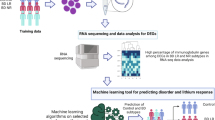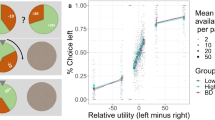Abstract
Lithium remains the gold standard for the treatment of bipolar disorder (BD); however, its use has declined over the years mainly due to the side effects and the subjective experience of cognitive numbness reported by patients. In the present study, we aim to methodically test the effects of lithium on neurocognitive functioning in the largest single cohort (n = 262) of BD patients reported to date by harnessing the power of a multi-site, ongoing clinical trial of lithium monotherapy. At the cross-sectional level, multivariate analysis of covariance (MANCOVA) was conducted to examine potential group differences across neurocognitive tests [California Verbal Learning Test (CVLT trials 1–5,CVLT delayed recall), Wechsler Digit Symbol, Trail-making Test parts A and B (TMT-A; TMT-B), and a global cognition index]. At the longitudinal level, on a subset of patients (n = 88) who achieved mood stabilization with lithium monotherapy, we explored the effect of lithium treatment across time on neurocognitive functioning. There were no differences at baseline between BD patients that were taking lithium compared with those that were not. At follow-up a significant neurocognitive improvement in the global cognitive index score [F = 31.69; p < 0.001], CVLT trials 1–5 [F = 29.81; p < 0.001], CVLT delayed recall [F = 15.27; p < 0.001], and TMT-B [F = 6.64, p = 0.012] was detected. The cross-sectional and longitudinal (on a subset of 88 patients) investigations suggest that lithium may be beneficial to neurocognitive functioning in patients with BD and that at the very least it does not seem to significantly impair cognition when used therapeutically.
Similar content being viewed by others
Log in or create a free account to read this content
Gain free access to this article, as well as selected content from this journal and more on nature.com
or
References
Burdick EK, Goldberg ET, Cornblatt AB, Keefe SR, Gopin BC, Derosse P, et al. The MATRICS consensus cognitive battery in patients with bipolar I disorder. Neuropsychopharmacology. 2011;36:1587–92.
Bora E, Yucel M, Pantelis C. Cognitive endophenotypes of bipolar disorder: a meta-analysis of neuropsychological deficits in euthymic patients and their first-degree relatives. J Affect Disord. 2009;113:1–20.
Burdick KE, Goldberg JF, Harrow M, Faull RN, Malhotra AK. Neurocognition as a stable endophenotype in bipolar disorder and schizophrenia. J Nerv Ment Dis. 2006;194:255–60.
Depp CA, Mausbach BT, Harmell AL, Savla GN, Bowie CR, Harvey PD, et al. Meta-analysis of the association between cognitive abilities and everyday functioning in bipolar disorder. Bipolar Disord. 2012;14:217–26.
Burdick EK, Russo M, Frangou S, Mahon K, Braga JR, Shanahan M, et al. Empirical evidence for discrete neurocognitive subgroups in bipolar disorder: clinical implications. Psychol Med. 2014;44:3083–96.
Bora E, Pantelis C. Meta-analysis of cognitive impairment in first-episode bipolar disorder: Comparison with first-episode schizophrenia and healthy controls. Schizophr Bull. 2015;41:1095–104.
Glahn DC, Almasy L, Barguil M, Hare E, Peralta JM, Kent JW, et al. Neurocognitive endophenotypes for bipolar disorder identified in multiplex multigenerational families. Arch Gen Psychiatry. 2010;67:168–77.
Naiberg MR, Newton DF, Collins JE, Dickstein DP, Bowie CR, Goldstein BI. Elevated triglycerides are associated with decreased executive function among adolescents with bipolar disorder. Acta Psychiatr Scand. 2016;134:241–8.
Naiberg MR, Newton DF, Collins JE, Bowie CR, Goldstein BI. Impulsivity is associated with blood pressure and waist circumference among adolescents with bipolar disorder. J Psychiatr Res. 2016;83:230–9.
Czepielewski LS, Massuda R, Goi P, Sulzbach-Vianna M, Reckziegel R, Costanzi M, et al. Verbal episodic memory along the course of schizophrenia and bipolar disorder: a new perspective. Eur Neuropsychopharmacol. 2015;25:169–75.
Geddes JR, Burgess S, Hawton K, Jamison K, Goodwin GM. Long-term lithium therapy for bipolar disorder: systematic review and meta-analysis of randomized controlled trials. Am J Psychiatry. 2004;161:217–22.
Geddes JR, Miklowitz DJ. Treatment of bipolar disorder. Lancet. 2013;381:1672–82.
Shine B, Mcknight RF, Leaver L, Geddes JR. Long-term effects of lithium on renal, thyroid, and parathyroid function: A retrospective analysis of laboratory data. Lancet. 2015;386:461–8.
Grandjean EM, Aubry J-M. Lithium: updated human knowledge using an evidence-based approach. Part II: Clinical pharmacology and therapeutic monitoring. CNS Drugs. 2009;23:331–49.
Pachet AK, Wisniewski AM. The effects of lithium on cognition: an updated review. Psychopharmacology. 2003;170:225–34.
Gitlin M. Lithium side effects and toxicity: prevalence and management strategies. Int J Bipolar Disord. 2016;4:27.
Burdick KE, Endick CJ, Goldberg JF. Assessing cognitive deficits in bipolar disorder: are self-reports valid? Psychiatry Res. 2005;136:43–50.
Wingo AP, Wingo TS, Harvey PD, Baldessarini RJ. Effects of lithium on cognitive performance: a meta-analysis. J Clin Psychiatry. 2009;70:1588–97.
Malhi GS, Tanious M, Das P, Coulston CM, Berk M. Potential mechanisms of action of lithium in bipolar disorder: Current understanding. CNS Drugs. 2013;27:135–53.
Kessing LV, Forman JL, Andersen PK. Does lithium protect against dementia? Bipolar Disord. 2010;12:87–94.
Engelsmann F, Katz J, Ghadirian AM, Schachter D. Lithium and memory: a long-term follow-up study. J Clin Psychopharmacol. 1988;8:207–12.
Smigan L, Perris C. Memory functions and prophylactic treatment with lithium. Psychol Med. 1983;13:529–36.
Oedegaard JK, Alda M, Anand A, Andreassen AO, Balaraman Y, Berrettini HW, et al. The Pharmacogenomics of Bipolar Disorder study (PGBD): identification of genes for lithium response in a prospective sample. BMC Psychiatry. 2016;16:129. https://doi.org/10.1186/s12888-016-0732-x.
Nurnberger JI Jr, Blehar MC, Kaufmann CA, York-Cooler C, Simpson SG, Harkavy-Friedman J, et al. Diagnostic interview for genetic studies: rationale, unique features, and training. NIMH Genetics Initiative. Arch Gen Psychiatry. 1994;51:849–59; discussion 863–4. PubMed PMID: 7944874.
Altman EG, Hedeker DR, Janicak PG, Peterson JL, Davis JM. The clinician-administered rating scale for mania (CARS-M): Development, reliability, and validity. Biol Psychiatry. 1994;36:124–34.
Montgomery SA, Asberg M. A new depression scale designed to be sensitive to change. Br J Psychiatry. 1979;134:382–9.
Rush AJ, Trivedi MH, Ibrahim HM, Carmody TJ, Arnow B, Klein DN, et al. The 16-item Quick Inventory of Depressive Symptomatology (QIDS), clinician rating (QIDS-C), and self-report (QIDS-SR): A psychometric evaluation in patients with chronic major depression. Biol Psychiatry. 2003;54:573–83.
Strauss E, Sherman E, Spreen O. A compendium of of neuropsychological tests: administration, norms and commentary. USA: Oxford University Press; 2006.
Wilkinson GS. Wide range achievement test 3. Wilmington, DE: Wide Range, Inc.; 1993.
Guhn M, Forer B, Zumbo BD. Reliable change index. In: Michalos AC, editor. Encyclopedia of quality of life and well-being research, Dordrecht: Springer Netherlands; 2014. p. 5459–62.
Woods SP, Delis DC, Scott JC, Kramer JH, Holdnack JA. The California Verbal Learning Test–second edition: test-retest reliability, practice effects, and reliable change indices for the standard and alternate forms. Arch Clin Neuropsychol. 2006;21:413–20.
Forlenza OV, De-Paula VJR, Diniz BSO. Neuroprotective effects of lithium: Implications for the treatment of Alzheimer’s disease and related neurodegenerative disorders. ACS Chem Neurosci. 2014;5:443–50.
Machado-Vieira R, Manji HK, Zarate CA. The role of lithium in the treatment of bipolar disorder: Convergent evidence for neurotrophic effects as a unifying hypothesis. Bipolar Disord. 2009;11:92–109.
Engel T, Goñi-Oliver P, Lucas JJ, Avila J, Hernández F. Chronic lithium administration to FTDP-17 tau and GSK-3β overexpressing mice prevents tau hyperphosphorylation and neurofibrillary tangle formation, but pre-formed neurofibrillary tangles do not revert. J Neurochem. 2006;99:1445–55.
Leroy K, Ando K, Héraud C, Yilmaz Z, Authelet M, Boeynaems JM, et al. Lithium treatment arrests the development of neurofibrillary tangles in mutant tau transgenic mice with advanced neurofibrillary pathology. J Alzheimers Dis. 2010;19:705–19.
Noble W, Planel E, Zehr C, Olm V, Meyerson J, Suleman F, et al. Inhibition of glycogen synthase kinase-3 by lithium correlates with reduced tauopathy and degeneration in vivo. Proc Natl Acad Sci USA. 2005;102:6990–5.
Matsunaga S, Kishi T, Annas P, Basun H, Hampel H, Iwata N. Lithium as a treatment for Alzheimer’s disease: a systematic review and meta-analysis. J Alzheimers Dis. 2015;48:403–10.
Rockenstein E, Torrance M, Adame A, Mante M, Bar-on P, Rose JB, et al. Neuroprotective effects of regulators of the glycogen synthase kinase-3β signaling pathway in a transgenic model of Alzheimer’s disease are associated with reduced amyloid precursor protein phosphorylation. J Neurosci. 2007;27:1981–91.
Su Y, Ryder J, Li B, Wu X, Fox N, Solenberg P, et al. Lithium, a common drug for bipolar disorder treatment, regulates amyloid-β precursor protein processing. Biochemistry. 2004;43:6899–908.
Chen RW, Chuang DM. Long term lithium treatment suppresses p53 and Bax expression but increases Bcl-2 expression. A prominent role in neuroprotection against excitotoxicity. J Biol Chem. 1999;274:6039–42.
Diniz BS, Teixeira AL. Brain-derived neurotrophic factor and Alzheimer’s disease: Physiopathology and beyond. NeuroMolecular Med. 2011;13:217–22.
Li H, Li Q, Du X, Sun Y, Wang X, Kroemer G, et al. Lithium-mediated long-term neuroprotection in neonatal rat hypoxia-ischemia is associated with antiinflammatory effects and enhanced proliferation and survival of neural stem/progenitor cells. J Cereb Blood Flow Metab. 2011;31:2106–15.
Kessing LV, Søndergård L, Forman JL, Andersen PK. Lithium treatment and risk of dementia. Arch Gen Psychiatry. 2008;65:1331–5.
de Sousa RT, van de Bilt MT, Diniz BS, Ladeira RB, Portela LV, Souza DO, et al. Lithium increases plasma brain-derived neurotrophic factor in acute bipolar mania: a preliminary 4-week study. Neurosci Lett. 2011;494:54–56.
Khairova R, Pawar R, Salvadore G, Juruena MF, De Sousa RT, Soeiro-De-Souza MG, et al. Effects of lithium on oxidative stress parameters in healthy subjects. Mol Med Rep. 2012;5:680–2.
Bearden CE, Thompson PM, Dalwani M, Hayashi KM, Lee AD, Nicoletti M, et al. Greater cortical gray matter density in lithium-treated patients with bipolar disorder. Biol Psychiatry 2007;62:7–16.
van Erp TGM, Thompson PM, Kieseppä T, Bearden CE, Marino AC, Hoftman GD, et al. Hippocampal morphology in lithium and non-lithium-treated bipolar I disorder patients, non-bipolar co-twins, and control twins. Hum Brain Mapp. 2012;33:501–10.
Lyoo IK, Dager SR, Kim JE, Yoon SJ, Friedman SD, Dunner DL, et al. Lithium-induced gray matter volume increase as a neural correlate of treatment response in bipolar disorder: a longitudinal brain imaging study. Neuropsychopharmacology. 2010;35:1743–50.
Moore GJ, Cortese BM, Glitz DA, Zajac-Benitez C, Quiroz JA, Uhde TW, et al. A longitudinal study of the effects of lithium treatment on prefrontal and subgenual prefrontal gray matter volume in treatment-responsive bipolar disorder patients. J Clin Psychiatry. 2009;70:699–705.
Yucel K, McKinnon MC, Taylor VH, Macdonald K, Alda M, Young LT, et al. Bilateral hippocampal volume increases after long-term lithium treatment in patients with bipolar disorder: a longitudinal MRI study. Psychopharmacology. 2007;195:357–67.
Acknowledgements
The authors thank the patient participants without whom this work would not be possible.
Author information
Authors and Affiliations
Contributions
JRK organized the consortium from which the data were generated. KEB conceived of the presented idea. KEB, CEM and MR participated in data analysis, interpretation of results, as well as the writing and critical review of the manuscript. MA, NA, AA, YB, WB, HB, JRC, C Calkin, C Conroy, WC, AD, SF, CF, NF, MF, KG, JG, ESG, KG, FSG, TG, GM, GJH, PJ, M Kamali, M Kelly, SL, EML, FWL, AXM, MJM, MM, CMN, JN, KJO, AO, MR, KR, M Schinagle, CS, M Shaw, PS, CS, ES, BT, and PZ assisted in data collection and review of the manuscript.
Corresponding author
Ethics declarations
Competing interests
KEB has served as an advisory board member to Dainippon Sumitomo Pharmaceutical Neuralstem, and Takeda-Lundbeck. JN has received funding as an investigator from Assurex and from Janssen. JRK has received funds from Pathway Genomics as an investigator. All other authors have nothing to disclose.
Additional information
Publisher’s note Springer Nature remains neutral with regard to jurisdictional claims in published maps and institutional affiliations.
Rights and permissions
About this article
Cite this article
Burdick, K.E., Millett, C.E., Russo, M. et al. The association between lithium use and neurocognitive performance in patients with bipolar disorder. Neuropsychopharmacol. 45, 1743–1749 (2020). https://doi.org/10.1038/s41386-020-0683-2
Received:
Revised:
Accepted:
Published:
Issue date:
DOI: https://doi.org/10.1038/s41386-020-0683-2
This article is cited by
-
Global Trends in the Use of Pharmacotherapy for the Treatment of Bipolar Disorder
Current Psychiatry Reports (2025)
-
A systematic review of the biomarkers associated with cognition and mood state in bipolar disorder
International Journal of Bipolar Disorders (2024)
-
Lithiumtherapie zur Behandlung affektiver Störungen im höheren Lebensalter
Der Nervenarzt (2024)
-
Lithiumtherapie zur Behandlung affektiver Störungen im höheren Lebensalter
Zeitschrift für Gerontologie und Geriatrie (2023)
-
Lithium produces bi-directionally regulation of mood disturbance, acts synergistically with anti-depressive/-manic agents, and did not deteriorate the cognitive impairment in murine model of bipolar disorder
Translational Psychiatry (2022)



